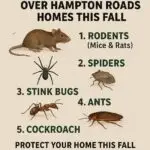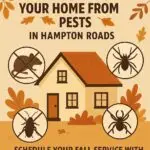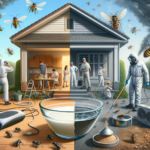
When it comes to protecting your home from pests, safety is a top priority—especially if you have children, pets, or concerns about the environment. Traditional pest control methods often rely on harsh chemicals that can pose risks to your health and the planet. Fortunately, eco-friendly pest control solutions offer an effective and safe alternative. In this guide, we’ll explore eco-friendly pest control methods and their benefits, ensuring that your home remains pest-free without compromising your family’s safety.
What Is Eco-Friendly Pest Control?
eco-friendly pest control definition”
Eco-friendly pest control, also known as green or natural pest control, involves using non-toxic, environmentally safe methods to manage and eliminate pests. These solutions are designed to target pests while minimizing harm to humans, pets, and the environment. By focusing on prevention, natural repellents, and organic treatments, eco-friendly pest control provides an effective way to keep pests at bay without the use of harmful chemicals.
Benefits of Eco-Friendly Pest Control
benefits of eco-friendly pest control”
Choosing eco-friendly pest control offers several advantages, making it an increasingly popular choice among homeowners:
- Safety for Family and Pets
Keyword: “safe pest control for family and pets”
One of the most significant benefits of eco-friendly pest control is its safety. Natural and organic products used in green pest control are free from toxic chemicals that can harm your family and pets. This means you can eliminate pests without worrying about exposure to harmful substances, making your home a safer place for everyone. - Environmentally Friendly
“environmentally safe pest control”
Eco-friendly pest control methods are designed to have a minimal impact on the environment. Unlike traditional pesticides, which can contaminate soil and water and harm beneficial insects, eco-friendly solutions are biodegradable and non-toxic to wildlife. By choosing green pest control, you’re helping to protect the planet while keeping your home pest-free. - Long-Term Prevention
“long-term pest prevention”
Eco-friendly pest control focuses on preventing infestations rather than just treating them. This approach often involves natural repellents, physical barriers, and habitat modification to make your home less attractive to pests. As a result, eco-friendly methods can offer long-term protection, reducing the likelihood of future infestations. - Targeted Treatments
“targeted pest control treatments”
Green pest control methods are often more targeted than traditional chemical treatments. For example, natural baits and traps can be used to target specific pests without affecting other wildlife or beneficial insects. This targeted approach helps to preserve the natural ecosystem while effectively managing pest populations. - Reduced Chemical Resistance
“chemical resistance in pests”
Pests can develop resistance to chemical pesticides over time, making them harder to control. Eco-friendly pest control methods reduce the risk of chemical resistance by using a variety of natural treatments that pests are less likely to adapt to. This makes green pest control an effective long-term solution for managing pests.
Eco-Friendly Pest Control Methods
“eco-friendly pest control methods”
There are several eco-friendly pest control methods available that can help you keep your home safe and pest-free. Here are some of the most popular options:
- Natural Repellents
“natural pest repellents”
Natural repellents use plant-based ingredients to deter pests. For example, essential oils like peppermint, eucalyptus, and citronella are known for their ability to repel insects like mosquitoes, ants, and spiders. These repellents can be applied around entry points, in gardens, or in areas where pests are commonly found. - Biological Control
“biological pest control”
Biological control involves using natural predators or parasites to manage pest populations. For instance, introducing ladybugs into your garden can help control aphid populations, while nematodes can target soil-dwelling pests like grubs. This method is highly effective and safe for the environment, as it relies on natural processes rather than chemicals. - Physical Barriers
“physical pest barriers”
Physical barriers like screens, traps, and nets can prevent pests from entering your home or garden. For example, installing door sweeps and window screens can keep insects out, while garden netting can protect plants from birds and other pests. These barriers are a simple yet effective way to reduce pest problems without the need for chemicals. - Organic Pesticides
“organic pesticides for home use”
Organic pesticides are made from natural ingredients and are designed to be less harmful to the environment than traditional chemicals. Examples include neem oil, diatomaceous earth, and insecticidal soaps. These products can be used to target specific pests without posing risks to humans, pets, or beneficial insects. - Integrated Pest Management (IPM)
“integrated pest management”
Integrated Pest Management (IPM) is a comprehensive approach to pest control that combines multiple eco-friendly methods. IPM focuses on understanding the behavior and biology of pests to develop effective prevention and control strategies. By using a combination of natural repellents, biological controls, and physical barriers, IPM offers a holistic and sustainable solution for managing pests.
How to Choose the Right Eco-Friendly Pest Control Plan
“choosing eco-friendly pest control plan”
Selecting the right eco-friendly pest control plan involves considering your specific needs and the types of pests you’re dealing with. Here are some factors to consider:
- Type of Pests
“specific pest control”
Different pests require different eco-friendly treatments. For example, mosquitoes may be deterred by citronella, while ants might be repelled by peppermint oil. Make sure the plan you choose includes methods that are effective against the pests in your home. - Severity of the Infestation
“severity of pest infestation”
If you’re dealing with a severe infestation, you may need a more comprehensive eco-friendly plan that includes multiple methods, such as traps, repellents, and biological controls. For less severe issues, a simpler plan with preventive measures may suffice. - Budget
“pest control budget”
Eco-friendly pest control solutions can vary in cost, depending on the methods used and the frequency of treatments. Consider your budget when selecting a plan, and look for options that provide effective protection without breaking the bank. - Professional vs. DIY
“professional pest control vs DIY”
While many eco-friendly pest control methods can be done yourself, some situations may require professional assistance. A professional pest control company can provide expert advice, apply treatments safely, and ensure long-term protection. Consider whether you want to handle pest control on your own or if you’d prefer to leave it to the experts.
Conclusion: Protect Your Home with Eco-Friendly Pest Control
Eco-friendly pest control solutions offer a safe, effective, and sustainable way to manage pests in your home. By choosing natural repellents, organic pesticides, and other green methods, you can protect your family, pets, and the environment from harmful chemicals. Whether you’re dealing with a current pest problem or want to prevent future infestations, eco-friendly pest control is the smart choice for a healthier home.
At Adibug, we specialize in eco-friendly pest control solutions that are tailored to your needs. Our expert team is here to help you choose the best green methods to keep your home pest-free and safe for your family and pets.
Website: Adibug.com
Phone number: 7578520085







